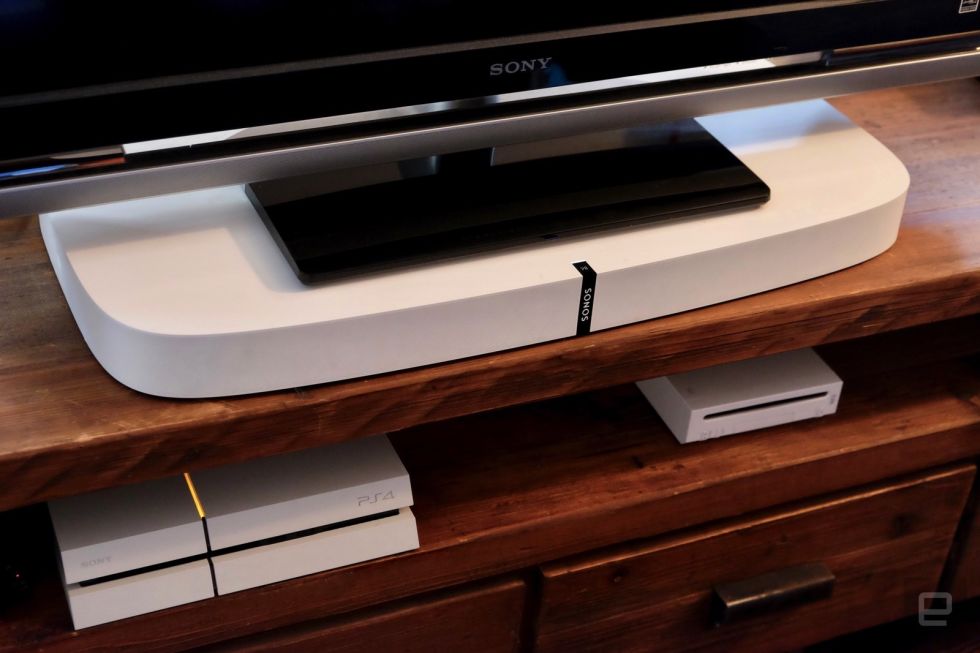Key Specs
The idea of having high-quality home theater audio seems great until you actually try and set it up. I’ve owned a few surround sound systems, but the additional speakers and cables added a level of complexity that never felt worth it to me. So I’ve been languishing for years with mediocre audio coming from my built-in TV speakers. It doesn’t sound great, but at least I have a clean setup that doesn’t require extra hardware and a mess of cables.
But the Sonos Playbase has me thinking that it’s time to upgrade. This massive speaker, wide and flat like a pizza box, is designed to sit underneath your TV, and includes three distinct audio channels as well as a built-in subwoofer. Like all other Sonos products, it uses WiFi to connect to other speakers and lets you stream music from just about any service you can think of, but it also outputs all of your TV audio. Sure, it’s not a full 5.1 setup, but a one-box, one-cord solution to upgrade my home theater seems like just what I need. Still, as with almost everything Sonos does, it doesn’t come cheap: $700 in this case. For those who want better sound in their living room, the Playbase is a compelling option — particularly if you’re a music fan.
Gallery: Sonos Playbase review | 11 Photos
-
-
-
-
+7
Engadget Score
Pros
- Clear, powerful audio regardless of whether you’re watching a movie or listening to music
- Music streaming is a unique feature in the home theater speaker market.
- Simple setup
- Excellent industrial design
- Easy to convert to a wireless 5.1 surround sound setup by buying extra speakers.
Cons
- Expensive, particularly if you’re building a 5.1 setup
- The lovely white finish scratches and scuffs easily
- Stereo separation isn’t as good as you’ll get with a true multi-speaker setup
Summary
As with most everything Sonos does, the Playbase is both excellent and expensive. But the combination of top-notch sound quality, versatility and simple setup makes it an extremely compelling speaker for the living room.
Hardware

The Playbase has an unusual shape compared with most speakers, but there’s a clear reason for this odd design: It’s meant to sit on a media stand with a TV on top. Sonos says the device can support most televisions up to 60 inches or up to 77 pounds. Bigger sets that have stands with legs on either side can usually be placed over the Playbase as well. Of course, it can be used with wall-mounted TVs too, but one of the speaker’s main selling points is that it can bear the weight of a television on top of it without an impact on audio quality. Indeed, Sonos claims that its research shows that 70 percent of TV owners never mount their TVs to the wall; if that’s true, there’s a lot of people who could use a speaker like the Playbase.
Like Sonos’ last speaker, the Play:5, the Playbase is a simple, sleek thing that shows great attention to detail. Yes, it’s a big plastic box, but the soft-touch finish feels extremely durable, not to mention pleasant underneath your fingers. That’s good, because there are a few touch-sensitive controls right near the front of the speaker. Other examples of the Playbase’s refined fit and finish include the CNC-drilled holes on the front face. Sonos specifically picked that pattern to minimize visual distraction without affecting sound quality. There’s only so much to say about a giant white box (it also comes in black), but it exudes polish and quality — something you definitely want from a $700 product.
All told, it’s an exceedingly simple device. There are those touch-sensitive controls on the front of the speaker. Tapping above the Sonos logo will play or pause music, while tapping to the left or right will decrease or increase volume. And you can swipe left to right to go forward in your playlist; swiping in the other direction goes back a track. These are the same controls that Sonos included on the Play:5, and they’re equally welcome here. The only other button is on the left side of the Playbase; you press it during setup to get the speaker connected to your WiFi network (more on setup in a moment). Around back are ports for power, Ethernet and optical audio. That’s it.
 This is a top view of the Playbase after a TV was placed on top of it. The gray bar is one of the TV legs, and it left some ugly scrapes just below it.
This is a top view of the Playbase after a TV was placed on top of it. The gray bar is one of the TV legs, and it left some ugly scrapes just below it.
The Playbase did let me down in one big way. As I was setting up my review unit, I somehow managed to put a few scuffs on the otherwise pristine white surface. I wasn’t really able to get them out either. While I haven’t noticed them since setting up the speaker, as they’re mostly covered by my TV, I was still disheartened to discover that I was able to mark up such a lovely device so easily. If you’re the type of person who moves a lot or is a bit harder on your belongings, you might be better off with the black version. In my case, though, the white speaker looks great alongside my white PS4, those scuffs notwithstanding.
Setup
The Playbase’s simplicity extends to the setup too. Once I placed the speaker under my TV, I plugged it into the wall and hooked it up with the included optical audio cable. The Sonos iOS app then walked me through everything I needed to do. (There’s an Android application as well.) Setup was a little easier, since I already had Sonos speakers in my house, which means I already have a Sonos account. Even so, starting from scratch is simple enough. The Sonos app scans and finds nearby speakers and connects them to the WiFi network your mobile device is on. All I had to do was follow the app’s directions and press the button on the side of the speaker to connect it and it was basically good to go. You’ll also likely need to switch your TV’s setting to output audio to an external device rather than its built-in speaker.
The Playbase uses the same “Trueplay” room-tuning technology that Sonos introduced alongside the Play:5 in late 2015. If you haven’t used it before, Trueplay basically adjusts the audio characteristics of Sonos’ speakers to make them sound as good as possible, regardless of where they’re placed in a room….







